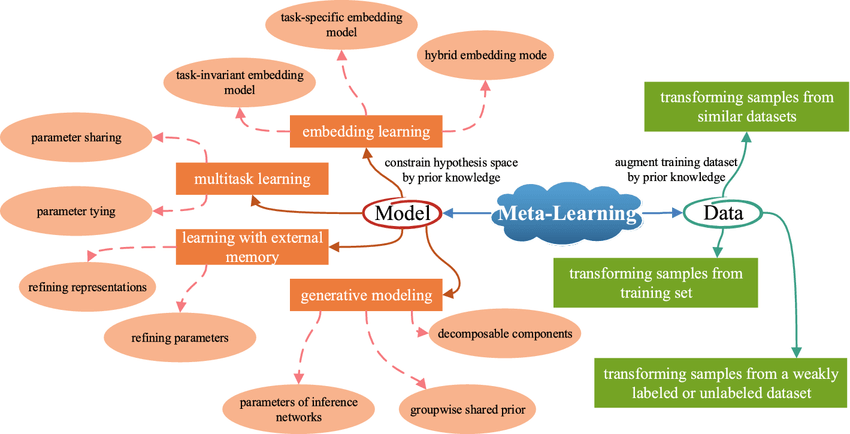
INTRODUCTION
A branch of machine learning called 'meta-learning' , frequently referred to as 'learning to learn', focuses on creating algorithms and models that can learn from experience and adapt to new tasks more rapidly and effectively than conventional machine learning techniques.
The main goal of meta-learning is to provide computers the ability to learn from a collection of tasks and transfer that knowledge to new, unexplored challenges. Hence, meta-learning algorithms can be applied to enhance learning efficiency, decrease the quantity of information required to learn new tasks, and optimise the learning process.
Natural language processing, computer vision, robotics, and reinforcement learning are just a few of the many potential fields that could benefit from the use of meta-learning.
By learning from a huge corpus of text data, for instance, meta-learning algorithms can be utilised in natural language processing to enhance language interpretation and creation. Meta-learning algorithms can be used in computer vision to recognise and categorise objects more rapidly and precisely than conventional deep learning techniques.
Why do we need Meta Learning:
In the field of machine learning, meta-learning is becoming more and more significant since it has a number of advantages over more conventional machine learning techniques. We require meta-learning for the following key reasons:
Improving learning efficiency:
Meta-learning algorithms can learn from a small collection of tasks and generalise this learning to other problems, increasing learning efficiency. By using less data and computer power to train models, this can result in considerable increases in learning efficiency.
Robustness to changes in data distribution:
Machine learning models frequently suffer when the distribution of the data used for training and that used for inference are different. By allowing models to build more reliable representations that can generalise to new data distributions, meta-learning can help to solve this issue.
Managing sparse or noisy data:
In some applications, gathering huge amounts of high-quality data may be difficult or expensive. By enabling models to gain more knowledge from smaller, noisier datasets, meta-learning can aid in overcoming this difficulty.
Overall, meta-learning can aid in enhancing the resilience, adaptability, and effectiveness of machine learning models, enhancing their usefulness across a variety of applications.

Generic learning algorithm vs a Meta Learner:
A generic learning algorithm is a machine learning algorithm that builds a model that is capable of making predictions on fresh data by learning from a training dataset. A generic learning algorithm's goal is to perform well on test data, which is made up of data points the model hasn't seen before. Typically, the algorithm looks for patterns or connections between the input features and the desired output using the input data.
A machine learning algorith called a meta-learner, in contrast, can adapt to new tasks by learning from a variety of training assignments. Learning a set of meta-parameters that can be utilised to quickly adapt to new tasks is the goal of a meta-learner.
This is accomplished by learning from a meta-training set made up of numerous training-test splits (otherwise known as episodes), where each episode stands in for a different task. These episodes teach the meta-learner how to generalise and how to apply this information to new tasks.
A meta-ability learner's to learn from many tasks and transfer this information to new tasks distinguishes it from generic learning algorithms. This makes meta-learning especially helpful when there is a lack of data, noisy data, or missing data for each given job. Moreover, meta-learning can be used to optimise hyperparameters or acquire efficient feature representations that can be applied to many tasks, increasing the effectiveness of machine learning algorithms.
Meta-learners and generic learning algorithms are both crucial machine learning tools, and which one to employ depends on the particular situation at hand and the data that is available.
Meta-Learning Variants and its Applications
Meta-learning comes in a variety of forms, each with its own set of methods and uses.
The most common variations and their uses are listed below:
Model-based meta-learning:This method entails developing a model that can forecast how various learning algorithms will perform on novel tasks. Both choosing the optimal algorithm for a particular task and tweaking the hyperparameters of those algorithms can benefit from this.
Metric-based meta-learning: A metric space that may be used to compare the similarity of various tasks is to be learned using the metric-based meta-learning approach. Transfer learning, in which skills acquired from one task are used on another that are somewhat comparable, can benefit from this.
Optimization-based meta-learning: Meta-learning based on optimisation entails learning an optimisation method that may be applied to swiftly adjust to new tasks. This can be helpful for learning with few instances, or few-shot learning, where the objective is to learn a new skill.
Bayesian meta-learning: This method involves learning a prior distribution across tasks using Bayesian techniques and updating that distribution as new tasks are encountered. This is helpful in sequential decision-making tasks where the agent must gradually gain knowledge through experience.
Applications of meta-learning include:
Few-shot learning: Learning from a small number of examples: Meta-learning can be used to learn how to quickly adjust to new tasks. Applications where data is hard to come by or expensive to obtain may find use for this.
Transfer Learning: Meta-learning can be utilised to acquire the skills necessary to move knowledge from one work to another. This can be helpful in situations where different jobs are comparable, like in computer vision or natural language processing.
Hyperparameter optimization: Meta-learning can be used to discover ways to improve the hyperparameters of learning algorithms for a certain task. With less requirement for human experience, the machine learning pipeline can be automated thanks to this.
CONCLUSION
Meta-learning is a potent method that can be employed to raise the efficacy and efficiency of machine learning algorithms




